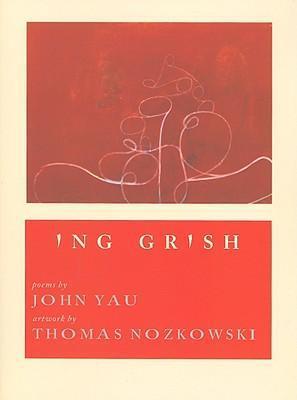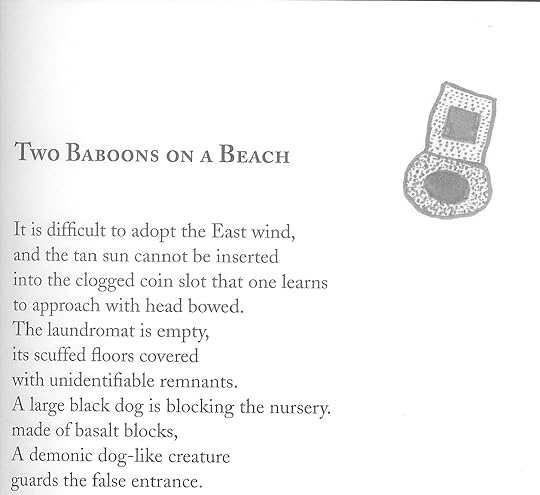John Yau and Thomas Nozkowski's Ing Grish
Ing Grish
(Saturnalia Books, 2005) is a book of poems by John Yau and artwork by Thomas Nozkowski. Yau's characteristic breadth of poetic experimentation and a self-referential and metacritical awareness of language and meaning are as usual present in the poems of this collection. The pairing of this poetry with Nozkowski's art is curious; it is definitely not the relationship of text-to-illustration but is a particular kind of juxtaposition that only barely puts the words and the visual art in conversation.

In the introduction to the book, Barry Schwabsky suggests that putting the work of this poet and visual artist together is in some ways simply an echo of how Yau builds an artistic community around himself, where people working in different media and with various perspectives on art come to associate with him and each other. But Schwabsky also suggests that both Yau and Nozkowski have an ability to exceed or frustrate expectations in their work. Furthermore, he writes that Nozkowski has a "fascination with the (possible arbitrary and contingent) associations that attach themselves to and modify any perception or memory," which points to an interest in the open-ended and constantly changing meanings of artworks. Schwabsky ultimately concludes, "What's at stake is a refusal of premature definition," and he notes that both Yau and Nozkowski share this intent on pushing for the disruption of too-easy-meaning.

Small illustrations by Nozkowski, almost like cellular parts afloat in a cell, appear on some of the pages of Yau's poetry. The shapes are abstract but suggestive, sometimes absurdist in their connections (or lack of connection) to Yau's words. The beginning of "Two Baboons on a Beach" depicted above shows a shape composed of a square squished against a circle. The list of objects observed at the beginning of the poem seem similarly to be a smooshing together of dissimilar things.

At other points, full-color art by Nozkowski are the only things on the page.
In "Diaspora," the speaker of the poem reminisces:
The final poem in the book is the title poem, "Ing Grish," full of insightful comments about corrupting language and cultural critique.
Both the poems by Yau and the art by Nozkowski are thoughtfully enigmatic at times.

In the introduction to the book, Barry Schwabsky suggests that putting the work of this poet and visual artist together is in some ways simply an echo of how Yau builds an artistic community around himself, where people working in different media and with various perspectives on art come to associate with him and each other. But Schwabsky also suggests that both Yau and Nozkowski have an ability to exceed or frustrate expectations in their work. Furthermore, he writes that Nozkowski has a "fascination with the (possible arbitrary and contingent) associations that attach themselves to and modify any perception or memory," which points to an interest in the open-ended and constantly changing meanings of artworks. Schwabsky ultimately concludes, "What's at stake is a refusal of premature definition," and he notes that both Yau and Nozkowski share this intent on pushing for the disruption of too-easy-meaning.

Small illustrations by Nozkowski, almost like cellular parts afloat in a cell, appear on some of the pages of Yau's poetry. The shapes are abstract but suggestive, sometimes absurdist in their connections (or lack of connection) to Yau's words. The beginning of "Two Baboons on a Beach" depicted above shows a shape composed of a square squished against a circle. The list of objects observed at the beginning of the poem seem similarly to be a smooshing together of dissimilar things.
It depends upon your pronunciations
It depends on whether the emphasis
Is on phlegm or ish
As in
do you speak Flemish

At other points, full-color art by Nozkowski are the only things on the page.
In "Diaspora," the speaker of the poem reminisces:
Upside down, the wok looked like a flying saucer, so I carefully surrounded it with rows of plastic Indians and Cuban gueriillas dressed like American marines. The only problem was that none of them had beards. It was the Fifties but already I was on the wrong side.I like the oblique reference to the Cold War, sci-fi alien stories, and nationalism.
The final poem in the book is the title poem, "Ing Grish," full of insightful comments about corrupting language and cultural critique.
I do not know Ing Grish, but I will study it down to itsThe claims the speaker makes about not knowing language unfurl into commentary about cultural misunderstanding and judgements about people based on the languages they do or do not speak and the ways they speak languages (with accents or in pidgin forms).
black and broken bones.
Because I do not know Chinese I have been told that meansTo speak a language or not to speak a language because a claim for and against cultural identity, to be authentic or not.
I am not Chinese by a man who translates from the Spanish.
Both the poems by Yau and the art by Nozkowski are thoughtfully enigmatic at times.
Published on July 03, 2013 12:26
No comments have been added yet.



